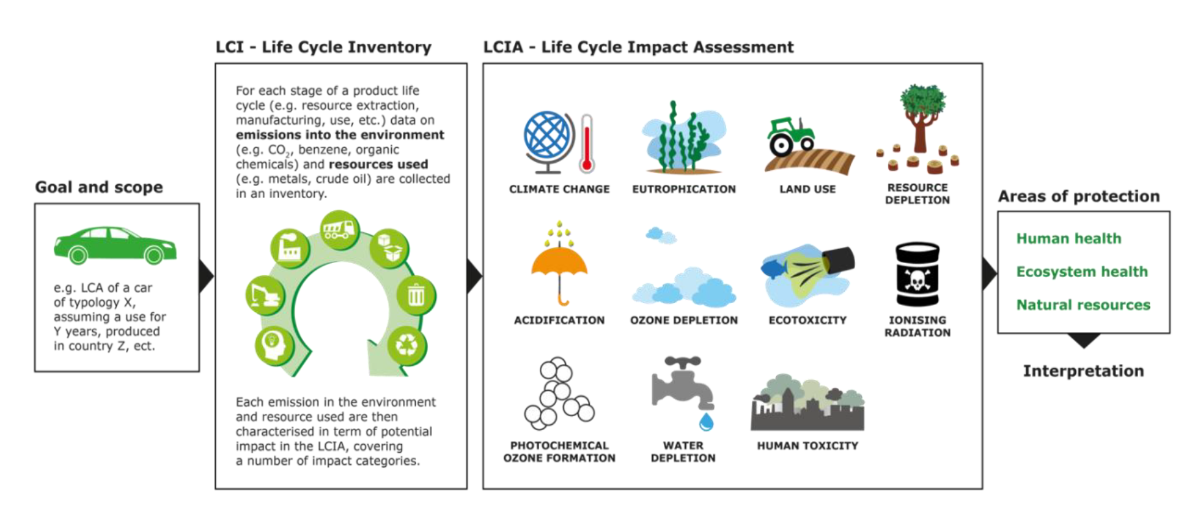
12 January 2024
ESPR: Redefining Sustainability in EU Product Design
As we get settled in 2024, the business landscape is set to transform with the introduction of the Ecodesign for Sustainable Products Regulation (ESPR).
This regulation, will be a cornerstone in the EU’s green deal, is a game-changer, set to replace the existing European Ecodesign Directive (Directive 2009/125/EC), bringing a fresh perspective to sustainable production within the internal market.
Its goal? To make sustainable products the standard in the EU market. This article delves deep into what ESPR entails for businesses, its history, future, possible impacts, and how it links to LCAs and other important sustainable practices.
Overview of the Ecodesign for Sustainable Products Regulation (ESPR)
The Current EU Ecodesign Directive: A Foundation to ESPR
The European Eco design Directive (Directive 2009/125/EC) established ecological standards within the EU for designing more than 30 product groups, including household appliances, electronics, and industrial equipment. This directive not only focuses on improving the energy efficiency of products but also considers other environmental aspects throughout their life cycle.
The Role of Energy Labeling in Ecodesign
Working in tandem with the Energy Labeling Regulation, it targeted energy-intensive products by setting design requirements and labeling standards. According to the European Commission’s calculations, the EU Ecodesign Directive saved around EUR 120 billion in energy expenditure. Which leads to a 10% lower annual energy consumption by the products in scope.
It demonstrates the efficacy of ecodesign and energy labeling. This outstanding result demonstrates the efficacy of ecodesign and energy labeling in encouraging a more sustainable market.
Incorporating Life Cycle Assessments (LCAs) in Ecodesign
Ecodesign, a sustainable design approach, uses environmental data, ideally from Life Cycle Assessments (LCA), to reduce a product’s environmental impact across its life cycle.
LCA analysis is a crucial step in starting your ecodesign journey, since it provides insightful data that includes the entire life cycle.This holistic approach to product design ensures that environmental considerations are integrated at every step, paving the way for substantial reductions in resource use and waste generation.
Let us now go into the potential replacement of the European Ecodesign Directive.
What is the Ecodesign for Sustainable Products Regulation ?
Proposed in March 2022, the ESPR marks a significant evolution from the current EcoDesign Directive.
On December 4, 2023, the European Union institutions agreed on a draft of the new ESPR law. This groundbreaking directive, aligned with the European Commission’s green public procurement policies, aims to transform the landscape of product sustainability and circularity across the EU, establishing a framework for sustainable product groups and a circular economy.
Which Products are Governed by the Sustainable Products Regulation?
As mentioned before, the proposal builds on the existing Ecodesign Directive. Which currently only covers energy-related products. The ESPR expands the EU’s existing ecodesign rules, which currently apply to electric appliances, to a wider range of products, including textiles, footwear and furniture. Additionally, for intermediary products, the priority lies in iron and steel.
Enhancing Sustainability and Circularity in Product Design
In the past, the eco design directive has been key in reducing energy consumption and saving costs for EU consumers, with an annual 10% reduction of energy usage by products in 2021 alone. Building on this success, ESPR extends its focus beyond energy-related products to encompass a broader spectrum of physical goods. This ambitious framework is set to redefine product design with an emphasis on:
- Durability and Reparability
Developing products that last longer and can be easily repaired or upgraded.
- Circularity
Minimizing waste by ensuring components and materials can be reused or recycled.
- Resource efficiency
Reducing the environmental impact through efficient use of energy and resources.
- Recycled Content
Promoting the use of recycled materials in new products.
- Environmental Footprint
Efficiently assessing the environmental impact of products, including their carbon footprint, through methods such as Life Cycle Assessments (LCAs.)
The Digital Product Passport: A Step Towards Transparency
A key innovation within the ESPR is the introduction of the Digital Product Passport. This tool will revolutionize how we interact with products, offering vital information on their sustainability attributes like durability, recycled content, and repairability. It enhances consumer awareness and facilitates repairs and recycling, bringing transparency to the products’ environmental impacts.

Global Reach of ESPR – Impact and Compliance Beyond EU
ESPR reaches beyond the EU’s borders, applying to all products entering the EU market, aligning with international trade rules. It encourages global partners to elevate their product sustainability standards, fostering a transition to a circular economy and establishing a framework for global sustainable production.
The Transition Phase: Continuing the Legacy
Until ESPR is fully implemented, the current Ecodesign Directive continues to guide product sustainability. The transition period serves as a bridge, gradually shifting focus from energy efficiency to comprehensive sustainability, in line with the EU’s working plan.
Anticipating the Impact of ESPR on Industries
With the European Union institutions agreeing on a draft of the new Ecodesign for Sustainable Products Regulations, industries are bracing a significant shift. Although not yet in force, this impending regulation is prompting industries to begin rethinking their product design and manufacturing processes. This section explores potential adaptations and challenges industries may face in anticipation of these regulations.
Preparing for ecodesign: Potential Industry Adaptations
- Electronics and Appliances:
As a sector likely to be heavily impacted by ESPR, electronics and appliances are progressively focusing on energy efficiency and reducing hazardous substances. - Textile Industry:
Anticipating the inclusion of textiles in ESPR’s scope, this industry is starting to shift towards sustainable materials, reduced water usage, and minimizing waste in production. The concept of a circular economy, emphasizing recycling and upcycling, is becoming more prominent in product strategies. - Furniture and Homeware:
In preparation for ESPR, this sector is exploring sustainable sourcing and designing products for durability and recyclability. Trends like modular designs for easy repairs and upgrades are gaining popularity. - Food and Beverage Industry:
This industry is likely to see changes in product packaging under ESPR, with a push towards sustainable packaging options and reduced food waste. There’s also a growing focus on sustainable sourcing of ingredients and reducing the carbon footprint of production and distribution processes. - Cosmetics and Personal Care Industry:
The cosmetics industry is adapting by reformulating products to reduce environmental impact, such as using biodegradable ingredients and sustainable sourcing. There’s also a movement towards eco-friendly packaging solutions and reducing the use of water and energy in production processes.
Proactive Approaches to Ecodesign Adaptation Challenges
- Cost Implications:
Adapting to ESPR is expected to require significant initial investments, particularly in developing products, finding sustainable materials, and changing production processes, a challenge that is especially acute for SMEs. - Supply Chain Readiness:
The need for supply chain adjustments in line with Ecodesign standards is prompting industries to start reevaluating their material sources and production practices, a complex task for those with extensive global networks. - Regulatory Anticipation:
Keeping pace with the developing ESPR framework and preparing for eventual compliance is a current focus. This includes proactive product redesign and setting up systems for future compliance monitoring. - Consumer Engagement:
Industries are starting to consider how to align their sustainable product initiatives with consumer expectations regarding performance, cost, and convenience. This involves not only redesigning products to meet environmental standards but also educating consumers about the benefits and importance of sustainable choices.
Preparing for ESPR: Embracing Life Cycle Assessment
Integrating LCA into the product portfolio is key for businesses gearing up for ESPR. LCA, a method evaluating a product’s environmental impact throughout its lifecycle, provides essential insights into environmental hotspots and potential improvements, setting the stage for compliance and developing a culture of eco-innovation.

Implementing LCA for Enhanced Sustainability
By conducting LCAs across their product range, companies can address critical areas of resource use, emissions, and waste generation. This aligns perfectly with ESPR’s criteria, positioning businesses as leaders in sustainable product innovation.
Beyond Compliance: Innovation and Consumer Trust
LCA goes beyond regulatory compliance, serving as a catalyst for creating environmentally friendly, energy-efficient products with mindful resource usage.
While LCA is a cornerstone of the ecodesign philosophy, its role within the ESPR framework is continually evolving. Businesses must stay agile and informed about these changes, ensuring their LCA practices are in line with the latest requirements and best practices.
By doing this, they not only comply with regulations but also become leaders in sustainable product innovation.
This integration of LCA into business operations is not just a regulatory requirement; it’s a strategic move towards a sustainable future. Aligning with future goals of ESPR and setting a new standard in product design and environmental stewardship.
Conclusion: Pioneering a Sustainable Future with ESPR
As the EU moves towards the adoption of the Ecodesign for Sustainable Products Regulation (ESPR). Industries are poised for a transformative shift in product design and sustainability. This regulation highlights the importance of Life Cycle Assessments (LCAs). In order to reduce environmental impacts and sets a new standard for sustainability across a broader range of products.
The ESPR draft not only signifies a step towards enhanced environmental responsibility but also underscores the need for businesses to adapt, innovate, and align with evolving consumer expectations in sustainability. It marks a pivotal moment in the journey towards a more eco-conscious and circular economy.
At Pilario, we make sustainability work the easy way. With our advanced LCA solutions, endorsed by industry giants like AB Inbev and L’Oréal, we empower businesses to seamlessly embrace eco-design and navigate evolving regulations. Our intuitive SaaS platform serves as a guiding light for industry leaders, integrating sustainability into their core strategies and propelling the market towards a greener future. We specialize in turning sustainability challenges into impactful business opportunities, making eco-practices accessible and effective.